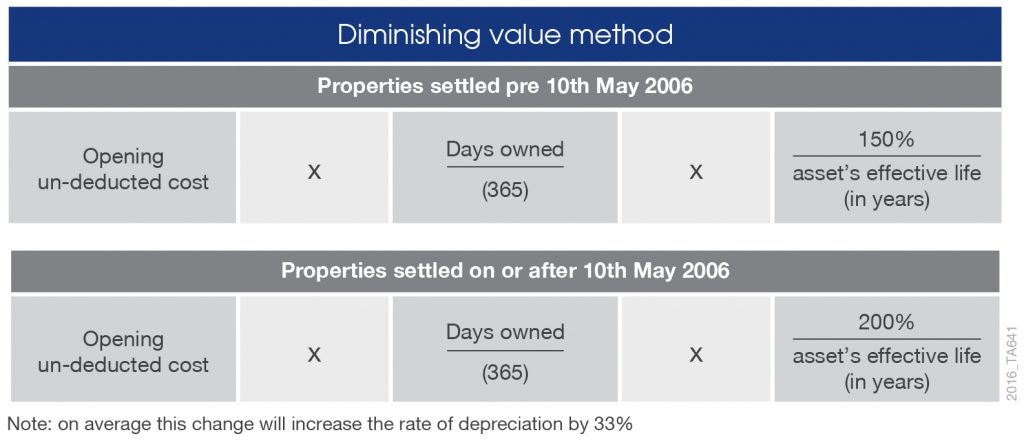Pick The Method To Suit Your Investment Strategy


The Australian Taxation Office (ATO) allows investors to choose between two methods of claiming depreciation on plant and equipment assets*. These are the diminishing value and the prime cost methods of depreciation.
When an investor makes their depreciation claim, they can choose only one of these methods, so it is important for them to understand how this choice will affect their investment returns.
Both the diminishing value and the prime cost methods claim the total depreciation value available over the life of a property. However, the two methods use different formulas to calculate depreciation deductions, achieving different short and long-term cash flow positions for the property investor.
Under the diminishing value method, the deduction is calculated as a percentage of the balance you have left to deduct. The formula a Quantity Surveyor will use to calculate depreciation using the diminishing value method is shown below.


Under the prime cost method, the deduction for each year is calculated as a percentage of the cost. The formula a Quantity Surveyor will use to determine the amount of depreciation deduction under the prime cost method is shown below.


The strategy of the individual investor must be considered when determining which method is the best choice for them.
If an investor makes their claim using the diminishing value method, they are claiming a greater proportion of the asset’s cost in the earlier years of the effective life of the asset as set by the ATO, therefore receiving greater deductions in the earlier years of owning the property. Alternatively, by selecting the prime cost method the investor is claiming a lower but more constant proportion of the available deductions over a longer period.
No matter what strategy an investor has, it is recommended they seek advice from an Accountant when making a decision.
A specialist Quantity Surveyor will always be able to provide a Capital Allowance and Tax Depreciation Schedule that outlines the depreciation deductions available to claim using both methods for comparison.
* Under proposed changes outlined in draft legislation (section 2 of Treasury Laws Amendment Bill 2017), investors who exchange contracts on a second hand residential property after 7:30pm on 9th May 2017 will no longer be able to claim depreciation on previously used plant and equipment assets. They can claim deductions on plant and equipment items they purchase and directly incur the expense. Investors who purchased prior to this date and those who purchase a brand new property will still be able to claim depreciation as they were previously. Investors should note that these changes are not yet law, as the legislation still needs to be passed through the senate for confirmation. BMT Tax Depreciation remain in discussion with government around the new changes and will keep our clients informed on the outcome. To learn more visit www.bmtqs.com.au/budget-2017.
To learn more about property depreciation, visit BMT Tax Depreciation’s property investor page on their website by clicking here. Alternatively, for obligation free advice contact the expert team at BMT on 1300 728 726.
Article provided by BMT Tax Depreciation.
Bradley Beer (B. Con. Mgt, AAIQS, MRICS, AVAA) is the Chief Executive Officer of BMT Tax Depreciation. Please contact 1300 728 726 or visit www.bmtqs.com.au for an Australia-wide service.
